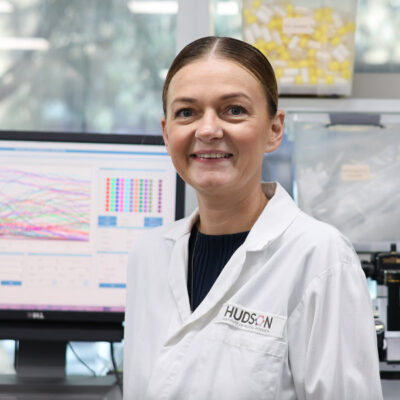The power of IFN-e: ovarian cancer breakthrough
By Rob Clancy, staff writer. Reviewed by Professor Paul Hertzog

In a significant breakthrough published in the top scientific journal, Nature Hudson Institute researchers have linked ovarian cancer to the absence of a naturally occurring protein in the female reproductive tract called interferon epsilon (IFN-e).
Ovarian cancer statistics
- Last year more than 1,000 Australians died of ovarian cancer,
- The likelihood of living more than five years with the disease is still less than 50 per cent
- Ovarian cancer is often diagnosed late, and the most common treatments have limited effectiveness, with resistance to chemotherapy a major factor.
The Hertzog lab research team had previously discovered that IFN-e exists in the female reproductive tract and was acting as a natural booster of immunity to infections. In this prestigious Nature study, the team have shown that IFN-e is found particularly around the ovaries, but is absent in patients with ovarian cancer.
The team’s pre-clinical results on ovarian cancer tissue samples were striking, confirming that IFN-e was a very effective natural tumour suppressor in ovarian cancer.
IFN-e protects against ovarian cancer development
Professor Paul Hertzog and the team established that IFN-e serves to protect the healthy body against the development of ovarian cancer, meaning it could potentially be used as a new way to fight the disease.
“We now know that IFN-e acts as a natural booster of immunity to infections. Our recent discovery is that IFN-e also acts as a tumour suppressant, and that it is lost during the process of ovarian tumour formation. The next question we need to ask is simply whether replacing this lost IFN-e could eliminate ovarian cancers in a safe and efficient way.” Prof Paul Hertzog
“The most common ovarian cancer treatments have limited effectiveness. This is a disease where new insights were needed,” Prof Hertzog said.
Excellence reaps rewards for ovarian cancer treatment
In a distinguished scientific career lasting four decades, Professor Paul Hertzog said that seeing his team’s latest research published in the influential journal Nature was a proud moment. While the publication carries prestige, it was the huge amount of work by many team members of the Hertzog lab over several years that gave him the most pride – specifically what it could mean for the treatment of ovarian cancer.
The research builds on 20 years of work harnessing the body’s own system of signalling proteins, specifically the discovery of Interferon epsilon (IFN-e) in 2004 by Prof Hertzog. It was initially driven by PhD student (now Dr) Zoe Marks and post-doc Dr Nollaig Bourke and continued by Dr Nicole Campbell.
IFN-e activates tumour fighting response
Dr Campbell built on the Hertzog research group’s understanding of IFNs in controlling inflammation, infections and cancer, to show that IFN-e combatted ovarian cancer by activating the body’s immune response to the fight tumours. This places IFN-e in the exciting new class of anti-cancer drugs called immunotherapies.
“Immunotherapies have been very successful in the treatment of other types of cancer, but they have had limited success in ovarian cancer – we’re looking to change that,” Dr Campbell said.
“We know that in High Grade Serous Ovarian Cancers (the commonest form of ovarian cancer) tumour cells recruit and activate ‘immunosuppressive’ cells that prevent anti-tumour immune cells from attacking the tumour. So, we’re aiming to develop new therapeutics that can reverse that process and improve survival rates.”
Hudson Institute leaders in IFN-e
Prof Hertzog explained that since his laboratory’s discovery of IFN-e in 2004, a great deal of progress has been made, with Hudson Institute leading the world in this type of research.
“At Hudson Institute we are now able to produce pure IFN-e, which allows us to conduct incredibly valuable research into how and where it can be used most effectively,” he said.
Journal | Nature
Title | Interferon-ε is a tumour suppressor and restricts ovarian cancer
View publication | https://doi.org/10.1038/s41586-023-06421-w
In this article
About Hudson Institute
Hudson Institute’ s research programs deliver in three areas of medical need – inflammation, cancer, women’s and newborn health. More
Hudson News
Get the inside view on discoveries and patient stories
“Thank you Hudson Institute researchers. Your work brings such hope to all women with ovarian cancer knowing that potentially women in the future won't have to go through what we have!”






